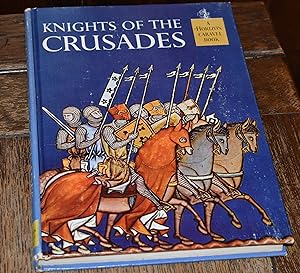jay williams margaret freeman (3 Ergebnisse)
Produktart
- Alle Produktarten
- Bücher (3)
- Magazine & Zeitschriften
- Comics
- Noten
- Kunst, Grafik & Poster
- Fotografien
- Karten
-
Manuskripte &
Papierantiquitäten
Zustand
- Alle
- Neu
- Antiquarisch/Gebraucht
Einband
Weitere Eigenschaften
- Erstausgabe (2)
- Signiert
- Schutzumschlag
- Angebotsfoto (1)
- Kein Print-on-Demand
Land des Verkäufers
Verkäuferbewertung
-
Knights of the Crusades
Verlag: American Heritage Pub Co, 1962
Anbieter: CHESIL BEACH BOOKS, WEYMOUTH, Vereinigtes Königreich
Buch Erstausgabe
Hardcover. Zustand: Fair. No Jacket. 1st Edition. No dj , heavy wear to boards , wear at extremities, tanned sides, otherwise good. 800 grams.
-
Knights of the Crusades
Verlag: Harper & Row, New York, 1965
Anbieter: Ground Zero Books, Ltd., Silver Spring, MD, USA
Erstausgabe
Mass market paperback. Zustand: Good. 128 pages. Slight soiling to cover. Illustrated with paintings, prints, drawings, and photographs, many of the period. (For this edition, details have been taken from certain paintings that were reproduced in full in the original edition.) Contains index. Margaret B. Freeman was Medievalist and curator, Cloisters, Metropolitan Museum of Art. She graduated from Wellesley College with a B.A, continuing for a master's degree at Columbia University. Freeman continued study at the College de France, Sorbonne, summer school. After returning, she worked as a research assistant at the Newark Museum, 1924-1925, and as an instructor at the Dana Hall School, a girls' boarding school in Wellesley, MA, between 1925-1927. She joined the Metropolitan Museum of Art first as a lecturer in the department of Egyptian and Medieval art in 1928. When the Cloisters opened in 1938, Freeman moved to the medieval-concentration museum, under James Rorimer, developing the medieval gardens and organized the music programs held there. She rose to assistant curator in 1940 and, when Rorimer was called to military duty in 1943, became associate curator, acting as director of the Cloisters until his return. Her interest in medieval gardens resulted in her book Herbs for the Mediaeval Household, published in 1943. After Rorimer's appointment as director of the Met in 1955, Freeman became curator of the Cloisters. She wrote two books on Cloisters textiles, the St. Martin Embroideries, 1968, and on the Museum's famous Unicorn Tapestries in 1976. She retired in 1965 as curator emeritus. Opening with the thunderous Norman conquest of England in 1066--thirty years before the First Crusade--this is the story of the 200-year struggle of the Christians to crush the infidel in the Holy Land. Although the Crusades failed to achieve their military or religious objectives, these wars waged by Christian nations to recapture the Holy Land left the world with amazing legends that have endured for ages. The Way of the Crusades explores this remarkable period, shedding light on an era that was once portrayed as only dark, recognizing the lasting achievements made in the field of the peaceful arts. A knight is a person granted an honorary title of knighthood by a head of state (including the pope) or representative for service to the monarch, the church or the country, especially in a military capacity. The background of knighthood can be traced back to the Greek hippeis and Roman eques of classical antiquity. In the Early Middle Ages in Europe, knighthood was conferred upon mounted warriors. During the High Middle Ages, knighthood was considered a class of lower nobility. By the Late Middle Ages, the rank had become associated with the ideals of chivalry, a code of conduct for the perfect courtly Christian warrior. Often, a knight was a vassal who served as an elite fighter, a bodyguard or a mercenary for a lord, with payment in the form of land holdings. The lords trusted the knights, who were skilled in battle on horseback. Knighthood in the Middle Ages was closely linked with horsemanship (and especially the joust) from its origins in the 12th century until its final flowering as a fashion among the high nobility in the Duchy of Burgundy in the 15th century. This linkage is reflected in the etymology of chivalry, cavalier and related terms. In that sense, the special prestige accorded to mounted warriors in Christendom finds a parallel in the furusiyya in the Islamic world. The ideals of chivalry were popularized in medieval literature, particularly the literary cycles known as the Matter of France, relating to the legendary companions of Charlemagne and his men-at-arms, the paladins, and the Matter of Britain, relating to the legend of King Arthur and his knights of the Round Table. First Perennial Library Edition. Presumed first printing.
-
Knights of the Crusade
Verlag: Cassell, 1963
Anbieter: Hay-on-Wye Booksellers, Hay-on-Wye, HEREF, Vereinigtes Königreich
Hardcover. Zustand: Good. This 1963 Hardcover edition is in a good clean condition throughout,marks to outer edge of pages, content not effected.



